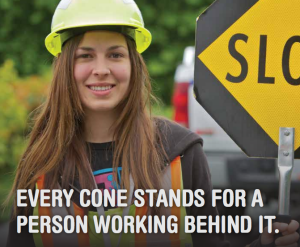I’d like to thank everyone who has shared their ideas and stories throughout the past year – helping Speaking of Safety live up to its name. I’d also like to thank all the readers – many who found their way here via Twitter, where I tweet as @SpeakinOfSafety.
Susan’s six top picks
Here are my top picks from the posts I wrote in 2013 – some of the issues I feel most strongly about. I hope people will consider these ideas and talk about them with loved ones.

Image from ConeZone.com poster
Go slow and pay attention to roadside workers looks at the dangers facing people who work on or near the roads. It is totally unacceptable that they are still getting hit while trying to earn a living.
Incident investigation should focus on change not blame is a reminder that a worker’s actions take place within a larger context. Factors such as staff shortages, inadequate training, malfunctioning equipment, planning for the work, or layout of the space are important considerations as well.
“It’s important to look beyond blaming an individual because change has a much greater level of safety benefit,” said Jenny Colman, a Human Factor Specialist/Ergonomist for WorkSafeBC’s Investigation Division, Incident Response Program.
“Ideally the person involved should be encouraged and supported to tell their story of the incident without blame or incrimination so organizations can learn from the event and make effective change in how the work is set up, planned and enacted.”
Get with the plan during agricultural safety week looks at an outreach program for rural youth and new workers on farms.
“Various toy-sized farm equipment props are placed on a farmscape mat, then participants are encouraged to identify where the operator could or couldn’t see them,” said Nicole Hornett, farm safety coordinator with Alberta Agriculture and Rural Development (South Region).
The workshop then looks at “…the best methods to get an operator’s attention through selecting safe locations to stand, using universal hand-signals as a method to communicate, or deciding if they can wait until the operator’s next break.”

Trevor Linden and yours truly – Susan Main, Speaking of Safety blogger – May 2, 2013 at the Terminal City Club in Vancouver, BC. Photo credit: Arne Huse/FIOSA-MIOSA
Former Canucks captain talks about leadership
Meeting Trevor Linden was a high point of my safety blogging year! The former Canucks captain spoke at the BC Safety Charter Round Table on May 2 in Vancouver and shared insight into why good leadership matters.
“Team sports and athletics naturally teach us about goal-setting. The best leaders broke the game down into sections and gave us a road map of where we want to be,” he told the crowd. “Details and structure are what makes good leaders.”
Shaming a texting driver in traffic is about how my son and I did our small part to stop distracted driving. But there’s still a lot to be done, if you notice how many people are texting and using phones behind the wheel.
Courses guide supervisors on leading safety shows what’s needed when a person is accountable for other workers. Trevor Davies is the occupational health and safety advisor for the City of Colwood, where eight supervisors have earned their program certificates.
“Not only must a supervisor know how to meet the vocational requirements of their position (whether public works, engineering, planning, administration) they must also meet the OH&S requirements, and labour relations requirements (both in union and non-union workplaces),” he said.
See you in 2014
My wish for the new year is that people will leave more comments on this blog. In the meantime, my wish for you is health, safety, and happiness for 2014.



These are all great top picks! I agree with the second topic because instead of blaming someone for the cause of the problem, it should be investigated and then corrected. This is to ensure that further harm or safety problems do not repeat themselves. Thanks for sharing!